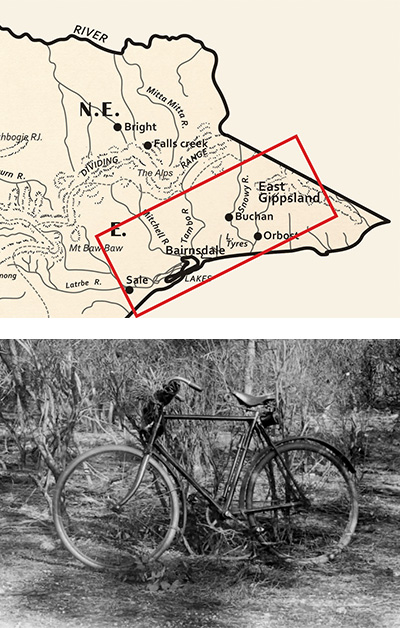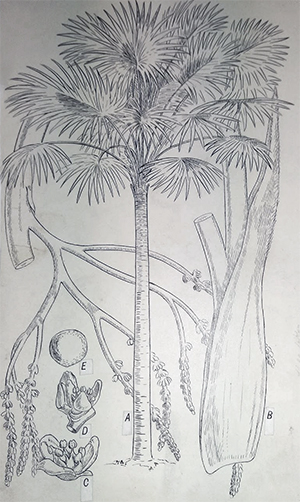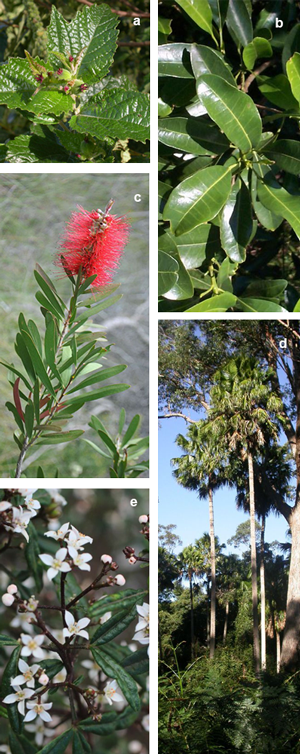A cycle trip through East Gippsland

In late 1910, H.B. Williamson set out to explore first hand the landscape that had been described to him only in correspondence by East Gippsland locals and fellow collectors J. Rowe, C.H. Grove, and E.E. Pescott — all of whom had sent botanical specimens from the region. In his report of this trip, published in the Victorian Naturalist, Williamson detailed his journey, which covered approximately 400 kilometres, all traversed predominantly on bike, over 12 days1.
By the end of his trip Williamson had documented 51 plant species and 13 bird species from the East Gippsland region. Besides the ‘blood thirsty female’ mosquitoes attacking him at Cabbage Tree Creek and the punctured tire on the last day of his journey, the trek was deemed to be a fruitful one by his peers at the Field Naturalists’ Club of Victoria.
Cabbage Tree Creek
At Cabbage Tree Creek, Williamson witnessed the isolated population of Livistona australis (Cabbage fan-palm) that had been documented by botanist Baron von Mueller, 60 years prior to his visit. He mused:
I must say that I felt, when standing among those plants, and thinking of the enthusiast who first saw them [von Mueller], that I was standing on an historic spot.1a
What made them a curious grouping was – and remains – their distribution so far south, with their nearest neighbour being approximately 300 kilometres away in New South Wales2. Williamson keenly documented the palms and urged the Field Naturalists Club of Victoria to investigate what measures were being taken to protect them. This location is now a Nature Reserve.

H.B. and the birds of East Gippsland
Williamson traversed vast riparian eucalypt forests, coastal heathland, rainforest, and along stretches of rivers and plains, all while collecting botanical specimens, ‘interviewing’ local apiarists and gardeners, and noting the habits of native birds.
In his article for the Victorian Naturalist Williamson reported:
The Banksias were alive with Blue Mountain Parrots, Trichoglossus novae-hollandiae, and Brush Wattle-birds, Anellobia chrysoptera* – both honey- eating birds, the latter one of the noisiest of honey-eaters.1b

He continued:
In a road-men’s camp nearby, while eating my lunch alone at the rude camp table, I had an experience I shall not readily forget. Two White-shafted fantails flew around me, and now and again perched first on my shoulder and then on my feet below the table. I would like to have met those road-men. I had quite a brotherly feeling towards them through our mutual friends the fantails. 1c

Above: Illustration of the White shafted fantail (Rhipidura flabellifera) by H. Gronvold5.
While some of Williamson’s interactions with nature were less romantic:
Under the palms and tree-ferns, blackwoods and lilli-pillies, the pretty little creek seemed to offer a delightful retreat where one could recline and enjoy the cool shade and wait quietly for the birds to come about for identification. How sadly was I disappointed, for I had scarcely unwrapped my lunch when I was assailed by thousands of mosquitoes and was constrained to bolt my food and get on the move to escape the bloodthirsty females.1d

Flora of the East Gippsland region
[a] Adriana tomentosa var. tomentosa
Eastern bitter-bush
In Victoria considered rare. Confined to East Gippsland where it often occurs in riparian habitats (VicFlora, 2021). © Neville Walsh, RBGB, 2021.
[b] Acronychia oblongifolia (A.Cunn. ex Hook.) Endl. Ex Heynh.
Yellow-wood
Confined to warm-temperate rainforest communities, usually near watercourses (VicFlora, 2021). © T.M. Tame, RBGB, 2021.
[c] Callistemon citrinus (Curtis) Skeels
Crimson bottlebrush
A specimen of this taxon was collected by Williamson during this trip. © Daniel Ohlsen, RBGB, 2021.
[d] Livistona australis (R.Br.) Mart
Cabbage Fan-palm
Very rare in Victoria where known from only three populations in the Orbost region2. © Neville G Walsh, RBGB, 2021.
[e] Zieria smithii Jacks.
Sandfly Zieria
Quite rare in Victoria (VicFlora, 2021). Collected by H.B. in Orbost. © Geoff Lay, RBGB, 2021.
References
1. Williamson HB. A cycle trip through East Gippsland. The Victorian Naturalist. 1911;28:69–77.
1a. Williamson HB. A cycle trip through East Gippsland. The Victorian Naturalist. 1911;28:69–77, p. 73.
1b. Williamson HB. A cycle trip through East Gippsland. The Victorian Naturalist. 1911;28:69–77, p. 72.
1c. Williamson HB. A cycle trip through East Gippsland. The Victorian Naturalist. 1911;28:69–77, p. 74.
2. VicFlora Royal Botanic Gardens Victoria. Livistona australis (R.Br.) Mart. [Internet]. South Yarra (Victoria): Flora of Victoria, Royal Botanic Gardens Victoria; 2016 [updated 2021 Feb 27; cited 2021 Apr 8]. Available from: https://vicflora.rbg.vic.gov.au/flora/taxon/8bce21c0-d48f-4408-83ac-c510c417bdb0
3. Ewart AJ. Handbook of Forest Trees for Victorian Foresters. Melbourne, Victoria: Government Printer; 1925. Plate 10, Livistona australis.
4. Higgins PJ, Christidis L, Ford H. Little Wattlebird (Anthochaera chrysoptera) [Internet]. Ithaca, New York: The Cornell Lab of Ornithology, Birds of the World; 2020 [updated 2013 Feb 10; cited 2021 May 2]. Available from: https://birdsoftheworld.org/bow/species/bruwat1/cur/introduction
5. Matthews GM. Birds of the World. London: H.F. & G. Witherby & Co.; 1921–1922.